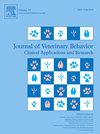Rectal temperature in Capra hircus, involvement of the daily rhythm of thyroid hormones, uncoupling protein 1 and clock gene Per2
IF 1.3
3区 农林科学
Q4 BEHAVIORAL SCIENCES
Journal of Veterinary Behavior-clinical Applications and Research
Pub Date : 2025-03-01
DOI:10.1016/j.jveb.2025.02.004
引用次数: 0
Abstract
Thermal homeostasis is one of the principal indexes of animal welfare; the circadian rhythm of body temperature is well established and its disruption or alteration are signals of stress. The present study investigated the daily rhythm of 3,5,3’-triiodothyronine (T3), thyroxine (T4), uncoupling protein 1 (UCP1), and clock gene Per2 in Capra hircus to improve the knowledge in this field. Camosciata delle Alpi goats (7 female, 2 years old, 67±2 kg, clinically healthy), were housed in a stable under natural environmental conditions. Blood sample collections were performed every 4 h for a 48-h period. Serum concentrations of T3, T4, UCP1, and clock gene Per2 were determined. Before the blood sample collection rectal temperature was recorded at all data points. Two-way for repeated measure analysis of variance showed a statistically significant effect of time of day on all studied parameters. T3, T4, Per2, and rectal temperature showed a robust daily rhythm. The acrophases observed in the investigated parameters were statistically different. In particular, T3 acrophase was observed between 20:15 and 21:45; T4 acrophase was between 02:41 and 03:35; Per 2 acrophase was between 7:18 and 08:11; RT acrophase was between 17:45 and 19:55. Per2 expression was correlated with T3 and T4 serum levels, and the rectal temperature values were correlated with T3 and T4 serum levels and Per2 In conclusion, in goats housed in boxes, the rectal temperature daily rhythm was linked to the daily rhythm of thyroid hormones and Per2 clock gene expression in the peripheral blood. In goats not subjected to thermal stress UCP1 did not show a daily fluctuation.
山羊直肠温度,甲状腺激素的日常节律,解偶联蛋白1和时钟基因Per2的参与
热稳态是动物福利的主要指标之一;体温的昼夜节律是确定的,它的中断或改变是压力的信号。本研究通过对卡普拉(Capra hircus)的3,5,3′-三碘甲状腺原氨酸(T3)、甲状腺素(T4)、解偶联蛋白1 (UCP1)和时钟基因Per2的日常节律进行研究,以提高对该领域的认识。山羊7只,母,2岁,67±2 kg,临床健康,饲养于自然环境条件下的马厩内。每4 h采集一次血样,持续48小时。测定血清T3、T4、UCP1和clock基因Per2的浓度。在采集血样之前,记录所有数据点的直肠温度。双向重复测量方差分析显示,一天中的时间对所有研究参数的影响具有统计学意义。T3、T4、Per2和直肠温度显示出强劲的日节律。所调查参数中所观察到的顶相有统计学差异。特别是在20:15 ~ 21:45之间出现T3顶相;T4顶相在02:41 ~ 03:35之间;每2顶相在7:18 ~ 08:11之间;RT顶相在17:45 ~ 19:55之间。Per2的表达与血清T3、T4水平相关,直肠温度与血清T3、T4水平和Per2相关。综上所述,箱养山羊直肠温度日节律与甲状腺激素日节律和外周血Per2时钟基因表达有关。在没有受到热应激的山羊中,UCP1没有显示出每日波动。
本文章由计算机程序翻译,如有差异,请以英文原文为准。
求助全文
约1分钟内获得全文
求助全文
来源期刊
CiteScore
3.50
自引率
16.70%
发文量
107
审稿时长
325 days
期刊介绍:
Journal of Veterinary Behavior: Clinical Applications and Research is an international journal that focuses on all aspects of veterinary behavioral medicine, with a particular emphasis on clinical applications and research. Articles cover such topics as basic research involving normal signaling or social behaviors, welfare and/or housing issues, molecular or quantitative genetics, and applied behavioral issues (eg, working dogs) that may have implications for clinical interest or assessment.
JVEB is the official journal of the Australian Veterinary Behaviour Interest Group, the British Veterinary Behaviour Association, Gesellschaft fr Tierverhaltensmedizin und Therapie, the International Working Dog Breeding Association, the Pet Professional Guild, the Association Veterinaire Suisse pour la Medecine Comportementale, and The American Veterinary Society of Animal Behavior.

 求助内容:
求助内容: 应助结果提醒方式:
应助结果提醒方式:


